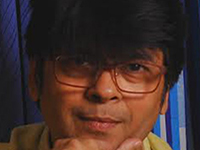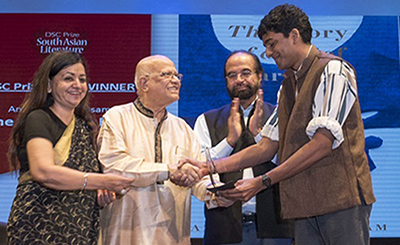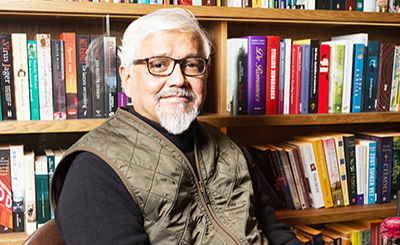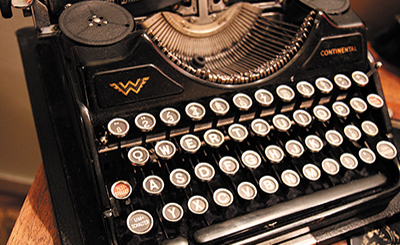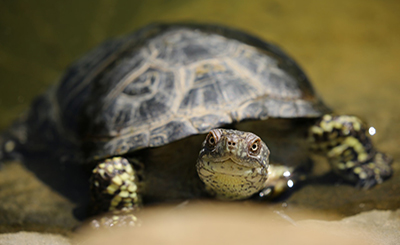Children go through everything that adults do: jealousy, pain, love, even lust. You could have asked any eight-year-old in Vidya Vihar what he thought of Miss DeCosta and watch him squirm with his phantom libido to confirm my theory. The one thing though that's the exclusive bastion of adults is nostalgia. And thank God for that. That is why children lamenting the passing of the old days, when they were microscopic swimmers in their dad's testicles, is a rarity. But, thanks to my father, I experienced what no child before me had — the best times I never had.
The '50s, when the family was living in Madras, had been a terrific time for my father by his own admission. It looked like my granddad's self-centeredness hadn't had any obvious side-effects. Dad had survived a childhood without formal education and emerged seemingly unscathed. He had a lucrative career going as a sought-after children's illustrator.
He was in his twenties, had his own money and could spend every last paisa of it on himself because Grandfather was happy taking care of things at home. Young men my father's age, whom he'd envied while they went to school and college, were earning a fraction of what he was after spending the entire day in a stuffy office.
If the blurb on his book covers was right, Dad was a pioneer in many ways. He was, it claimed, among the first comic book illustrators in India, the country's youngest children's book publisher, the first to win awards in three languages and so on. What the blurb didn't mention was that, in the conservative '50s, it's quite possible he was also the country's first serial consumer. Unfettered by responsibility, coddled by his father and powered by earnings that far exceeded anyone of his age or background, Dad indulged himself silly. He watched every Hollywood movie that came to town, flitting giddily between Casino and Minerva, and bought any English film magazine he could lay his hands on. He developed a taste for fancy clothes and treated himself, as he boasted to us so often, to a new rayon bush-shirt every week. He had owned fifty pairs of shoes and god-knows-how-many hair-care products. That he didn't get into "booze and broads" like the gumshoes of his staple entertainment must have been more an indication of our familial propensity for inaction rather than any inherent saintliness.
Then came responsibility in the annoying form of my mother and the three of us. Whether he liked it or not, baby food cut into his shirt budget. Dad realised that he couldn't magically turn into a bachelor every evening and disappear to a mmatinée with a friend. (Not that he'd stopped doing that entirely but had cut down to about once a week). So he did the next best thing. He continued to live in the '50s. Any conversation with him invariably led to the Golden Age of Hollywood. All we heard was about Lauren Bacall's voice, John Wayne's gait or Tyrone Power's profile. Every little fancy of ours, which naturally had to do with our now (the '70s), was pooh-poohed with a bigger, better, more beautiful '50s' example.
Dad: What are those ridiculous trousers you're wearing?
Sis: Bell-bottoms.
Dad: Only sailors wear bell-bottoms. Don't you remember Gene Kelly in On the Town?
Sis: They're in fashion now, Naanna. Everyone in school's wearing them.
Dad: Why don't you wear those dresses like Debra Paget in Ten Commandments? They look so nice.
Apparently, my father was under the impression that the Old Testament had unfolded in the '50s.
Dad was a terrific storyteller and, on the odd rainy evening, forced to stay indoors, he could be coaxed into telling us stories. While other kids heard of Krishna's love for his childhood friend Sudama or the brave exploits of Bhima from their grandmothers, we were narrated the plot lines of such movies as A Place in the Sun or Bad Day at Black Rock, sound effects and all.
Dad's jealously guarded library was a shrine to '50s pop culture. There were issues and issues of Picturegoer, Screen Stories and Photoplay arranged chronologically and maintained in mint condition. There were equally well-stocked sections of pulp fiction, pocket cartoon books and comic books. If Martians had blown Earth to smithereens and the only thing that survived was my father's library, they would have had a pretty good idea of what Americans were up to in the '50s — provided they could read English.
It was only natural, what with the running commentary on the fabled '50s, that I found myself drawn to Dad's collection of books. On weekends, after having learnt to jimmy the lock to the cupboards from a resourceful friend, I quietly disappeared with a stack of well-chosen mags and comics to the little room at the top of the staircase. In that little oven of a room, where the hot air of the entire house was trapped, I spent hours looking at Gina Lollobrigida's magnificent cleavage, Alan Ladd's fading good looks and publicity shots of a nineteen-year-old starlet on the verge of discovery called Joan Collins. I read the columns of Walter Winchell and Hedda Hopper. I was mesmerised by the black-and white illustrations of Sun Comics featuring the adventures of a sanitised Billy the Kid. Somehow, American comic book manufacturers had turned the notorious real-life outlaw into a masked crusader of the poor and downtrodden. All by myself, I laughed out loud at the exploits of Tubby, Little Lulu, Iodine and Donald Duck. And though I didn't fully get the humour of the French cartoons, the topless women made it amply clear that they were all about the same subject. The variety of illustration styles on display was incredible, and I made it a point to note the names of the artists. Campaign's style was meticulous, almost sculpture-like; Hogarth's figures had lithe bodies and adopted near-impossible poses; Marge and Cavalli, the funny guys, used very few lines but their pictures were just as terrific, while Jimmy Hatlo seemed to enjoy drawing excruciatingly ugly kids.
It's common for older siblings to pass on an old geometry box or a pair of trousers they've outgrown to a younger member of the family. Those can be put away in a dusty corner of your cupboard. But the hand-me-down fixation of an obsessive parent is impossible to discard. Maybe it was because I listened harder or maybe it was because my father was aloof and I wanted his attention. But it was I, far more than my sisters, who became his willing and enthusiastic slave.
Dad was my hero. He could draw, he was a walking Hollywood dictionary, and owned the best comics in the world. He was the King of Hep.
Like most kids, I didn't realise this was all stuff he considered important. Also, I never did consider whether I'd have been similarly infected had his thing been nuclear physics. I constantly quizzed him on "our" favourite subject, and he was more than happy to give me his unshakeable opinion.
"Naanna, who's handsomer? Gregory Peck or Cary Grant?"
"Neither. It's Tyrone Power. Gregory Peck's cheeks are too hollow and Cary Grant's lower lip sticks out. Tyrone Power is flawless."
Like a big-eared parrot, I repeated everything he said to my friends at Vidya Vihar who didn't know Hollywood from balsa wood.
When I wasn't listening to Dad talk films, I loved to watch him draw. My small moda was a permanent fixture in his studio. It was set to his left, so as not to hinder his drawing hand, in the tiny space between his easel and the comic-filled cupboard. I knew from the comics I read that putting one together was a team effort. If you looked at the credits at the bottom of the first page, there was a storywriter, a penciller, an inker, a colourist, a letterist and an editor. Sometimes the comics carried little bios of them. They were all professionally trained, had gone to art school and got all kinds of degrees. How come my father, who'd never seen the inside of a classroom, did all these jobs himself?
Watching Dad draw was like witnessing a daily magic show from a dress-circle seat. A typical page of his comic art took shape in this manner. Taking a crisp machine-trimmed page, he first divided it into three equal rectangles drawn one below the other. Then he pencilled in the script into the boxes. Oval bubbles with a pointy tail directed towards the speaker encompassed speech and cloud-shaped bubbles with steadily shrinking tiny circles at their bottom indicated thoughts. Even-toothed starbursts surrounded Indianised sound effects, Dham for "Crash" and Bhal for "Splash".
With words out of the way, the artist took over. This was the part I liked. Using a Venus HB pencil, Dad made people and places appear magically on the page in their rough form. Construction lines that wouldn't appear in the final drawing fixed features in their proper place on faces, and limbs in their right proportion on the bodies. Expertly, he alternated close-ups with long shots and mid-range shots to best convey the drama in the story. For instance, the opening panel of a comic book was invariably a long shot.
"How will the reader know where the story is taking place unless you establish the location and atmosphere right in the beginning?" he would say.
People reacting in surprise or fear was almost always a close-up. "The reader needs to see the expression of the character."
And a close-up very rarely followed another close-up. "Monotony! You've got to mix it up. Change the angles."
Then came the inking of the picture. This was the time for hard decisions. A line once inked would remain there for eternity. Dad detested using Poster White to opaque out errors. Using a variety of nibs and brushes dipped and redipped in Camel 99 Indelible Ink, he miraculously chose the correct line among the mess of pencil strokes and construction lines of the sketch. With every stroke, the wet ink from the nib caught the light and glittered for a magical fraction of a second before being sucked in by the thirsty paper. Shadow and highlight appeared seamlessly as the drawing progressed.
When the inking was done, and the page was suitably dry, I was called in for a job that has never been credited on the pages of any comic book — the Eraser.
As Dad had his mid-morning coffee, I carefully erased all the pencil lines and shook out the rubber crumbs while staring in wonder at the page. Magicians betrayed princes, horses came back riderless to castles and beautiful, bustier-clad damsels wept, imprisoned in dungeons. The slim lithe hero, with a scimitar hanging from his waistband, always sported an impeccable hairstyle, like his Brilliantine-saturated counterparts from Dad's Hollywood.
In the last box of every page was my father's groovy signature: "Bujjai". Now, that was a name for a cartoonist.
The colouring style Dad adopted for his comic strips was almost childlike, flat, even coats of prime colour filled in carefully so as not to breach their ink line boundaries. For this, he used something called "photo colours", originally created to colourise black-and-white publicity stills of films to make multicoloured posters. It seemed there was no keeping apart my father and films. He had figured out somehow that photo colours, with their vibrant, transparent nature, suited his comic book art.
Instead of the usual bottles or tubes, these colours came in books. These fascinating little things, roughly the size of a cheque book, contained sheets of metallic paper with names like Peacock Blue, Vermillion, Chrome Yellow and Leaf Green. When a small piece of the required shade was put on a plate and a few drops of water added, the colour would bleed onto the plate in dreamy tendrils. It was just about the neatest trick I'd ever seen in my life. However many times I saw this, it continued to amaze me. I always wondered who the genius who invented photo colour papers was.
The colouring itself was an organised affair. Instead of finishing up all the colours in one panel and moving to the next, it was done clinically, colour by colour, several pages at a time. The yellows were filled in first in all the pages, then the blues, the greens and so on.
One day, having been served up with an imposition in school, I got into trouble for incorporating this method in the hope of finishing it quick time. My writing task — "I will submit my homework on time" — to be written a hundred times. Instead of writing the entire sentence once and moving on to the next line, I tried writing a hundred "I"s first, followed by a hundred "will"s, and so on. I was caught by my teacher who seemed mad for some reason. My punishment: another imposition that went "I will write impositions horizontally and not vertically".
Sometimes, Dad dabbed the colours on an overlay sheet of tracing paper instead of applying them directly on the page. Then the Gateway sheet would shrivel up like my granddad's skin and the resultant blurred multicoloured quilt of an indefinite pattern wouldn't make much sense to me.
One day I asked him: "How's anyone going to make out which colour goes where, Naanna?"
Dad gave me a knock on the head, turned the page around, and held it up to the window. As light passed through the tightly stretched overlay sheet and the drawing, I could see the hero's tunic in red, the foliage in green and all the colours exactly in their place — clear as a printed page! Now, how in hell had he figured that out?
When I told him I wanted to be a children's illustrator when I grew up, Dad told me three things: that the key element in a children's drawing was expression, that I should never hesitate while drawing a line even if it was going wrong and, most importantly, that he'd kick me in the ass if I ever entertained the idea of becoming an artist.
(Adapted from Ice Boys in Bell-bottoms, 2011)




